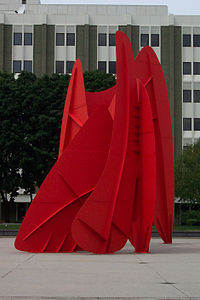
Alexander Calder was an American sculptor known both for his innovative mobiles that embrace chance in their aesthetic, his static "stabiles", and his monumental public sculptures. Calder preferred not to analyze his work, saying, "Theories may be all very well for the artist himself, but they shouldn't be broadcast to other people."

Grand Valley State University is a public university in Allendale, Michigan. It was established in 1960 as Grand Valley State College. Its main campus is situated on 1,322 acres (5.35 km2) approximately 12 miles (19 km) west of Grand Rapids. The university also features campuses in Grand Rapids and Holland and regional centers in Battle Creek, Detroit, Muskegon, and Traverse City.
Hammering Man is a series of monumental kinetic sculptures by Jonathan Borofsky. The two-dimensional painted steel sculptures were designed at different scales, were painted black, and depict a man with a motorized arm and hammer movement to symbolize workers throughout the world. They were structurally engineered by Leslie E. Robertson Associates (LERA).

Mountains and Clouds is a sculpture by Alexander Calder located in the Hart Senate Office Building.

Frederik Meijer Gardens & Sculpture Park is a 158-acre (64 ha) botanical garden, art museum, and outdoor sculpture park located in Grand Rapids Township, Michigan, United States. Opened in 1995, Meijer Gardens quickly established itself in the Midwest as a major cultural attraction jointly focused on horticulture and sculpture.
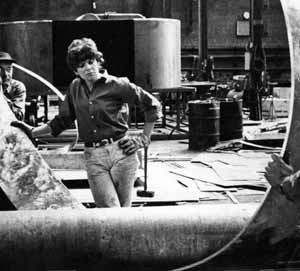
Beverly Pepper was an American sculptor known for her monumental works, site specific and land art. She remained independent from any particular art movement. She lived in Italy, primarily in Todi, since the 1950s.

Lyman Emmet Kipp, Jr. was a sculptor and painter who created pieces that are composed of strong vertical and horizontal objects and were often painted in bold primary colors recalling arrangements by De Stijl Constructivists. Kipp is an important figure in the development of the Primary Structure style which came to prominence in the mid-1960s.

Flamingo, created by noted American artist Alexander Calder, is a 53-foot-tall (16 m) stabile located in the Federal Plaza in front of the Kluczynski Federal Building in Chicago, Illinois, United States. It was commissioned by the United States General Services Administration and was unveiled in 1974, although Calder's signature on the sculpture indicates it was constructed in 1973.

The Festival of the Arts – known locally as simply Festival, typically with the year added – is a three-day multimedia arts festival, held in Grand Rapids, Michigan on the first Friday, Saturday, and Sunday of June. The event features live performances of music, dance, and other performing arts; displays and sales of paintings and other visual arts; art and sculpture opportunities for children; film/video and literary presentations; and a wide variety of multicultural food booths operated by local non-profit organizations. Typically involving nearly 20,000 community volunteers and over half a million visitors, according to the Library of Congress, Festival is the largest all-volunteer arts festival in the United States.

Centre Square is an office complex in Center City Philadelphia, Pennsylvania. The complex consists of two concrete high-rise towers: the 417 feet (127 m) Centre Square I, also known as Centre Square East, and the 490 feet (150 m) Centre Square II represent the 24th and 15th-tallest buildings in Philadelphia, respectively. Designed by Vincent Kling & Associates in the 1960s, Centre Square opened in 1973. The complex is credited with shifting Philadelphia's downtown office district from South Broad Street to West Market Street. A tenant since 1975, management consulting firm Willis Towers Watson is Centre Square's largest tenant.
Robert Gray Murray is considered by some to be Canada's foremost abstract sculptor. He also has been called the most important sculptor of his generation worldwide. His large outdoor works are said to resemble the abstract stabile style of Alexander Calder, that is, the self-supporting, static, abstract sculptures, dubbed "stabiles" by Jean Arp in 1932 to differentiate them from Calder's mobiles. Murray focused on "trying to get sculpture back to its essential form", he has said. His work is like colour-field abstraction.

"Holler Back" is a song written by Stokes Nielson and Tim James, and recorded by American country music band The Lost Trailers. The song is the band's fourth chart single on the Billboard Hot Country Songs charts, and their first Top 40 hit on that chart. It was released in February 2008 as the title track and lead-off single to their album Holler Back, released in August 2008 on BNA Records.
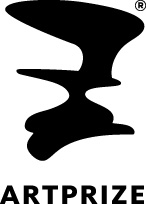
ArtPrize is an art competition and festival in Grand Rapids, Michigan. Anyone over the age of 18 can display their art, and any space within the three-square-mile ArtPrize district can be a venue. There are typically over 160 venues such as museums, galleries, bars, restaurants, hotels, public parks, bridges, laundromats, auto body shops, and more.

The Everett McKinley Dirksen United States Courthouse, commonly referred to as the Dirksen Federal Building, is a skyscraper in the Chicago Loop at 219 South Dearborn Street. It was designed by Ludwig Mies van der Rohe and completed in 1964. The building is 384 feet (117 m) tall with 30 floors; it was named for U.S. Congressman Everett Dirksen. The building houses the United States Court of Appeals for the Seventh Circuit, the United States District Court for the Northern District of Illinois, the United States Bankruptcy Court, the United States Marshal for the Northern District of Illinois, United States Attorney for the Northern District of Illinois, and local offices for various court-related federal agencies, such as the Federal Public Defender, United States Probation Service, United States Trustee, and National Labor Relations Board. It is one of three buildings making up the modernist Chicago Federal Center complex designed by van der Rohe, along with Federal Plaza, the U.S. Post Office and the Kluczynski Federal Building. Separate from the Federal Plaza, but opposite the Kluczynski Building across Jackson Boulevard, is the Metcalfe Federal Building.
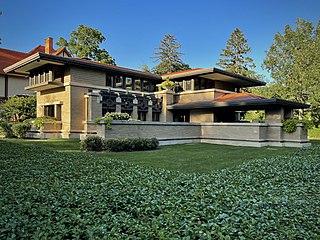
Grand Rapids is a city and county seat of Kent County in the U.S. state of Michigan. At the 2020 census, the city had a population of 198,893 which ranks it as the second most-populated city in the state after Detroit. Grand Rapids is the central city of the Grand Rapids metropolitan area, which has a population of 1,087,592 and a combined statistical area population of 1,383,918.

Gwenfritz is a painted steel abstract stabile, by Alexander Calder. It is located at the National Museum of American History, at 14th Street, and Constitution Avenue, in Washington, D.C.

Bent Propeller was a red stainless steel sculpture by Alexander Calder.
Norie Sato is an artist living in Seattle, Washington. She works in the field of public art using sculpture and various media–including glass, terrazzo, plastic film, stone, and metal–and often incorporating lighting effects, landscaping, mosaics, prints, and video. She frequently collaborates with architects, city planners, and other artists and specializes in integrating artwork and site specific design.
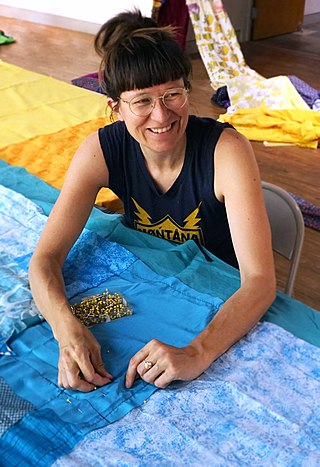
Amanda Browder is an American installation artist known for her large-scale fabric installations on building exteriors and other public sites. Her work incorporates donated materials and local volunteers, creating site-specific art. She is the recipient of grants from the National Endowment for the Arts, and Transformation Fellowship from the University of Nevada, Las Vegas (UNLV).
